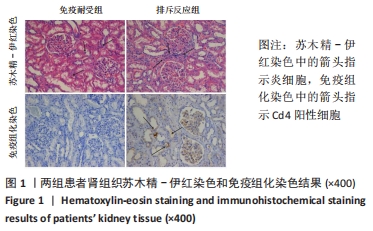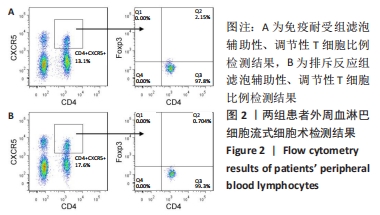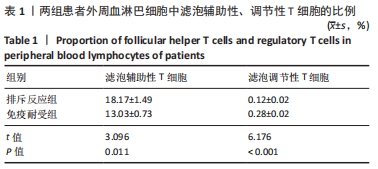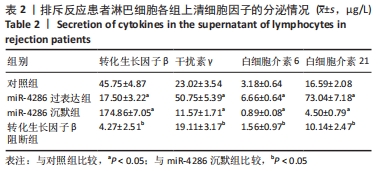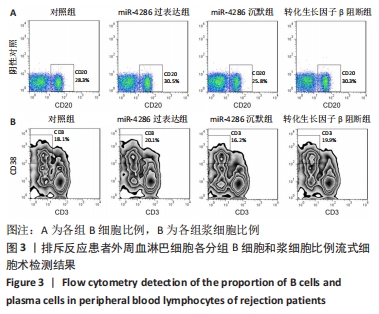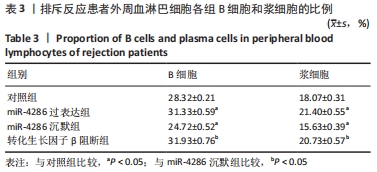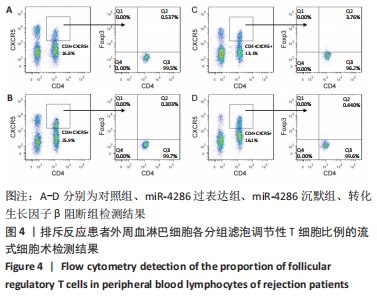[1] JORDAN SC, AMMERMAN N, CHOI J, et al. Novel Therapeutic Approaches to Allosensitization and Antibody-mediated Rejection. Transplantation. 2019;103(2): 262-272.
[2] SCHINSTOCK CA, MANNON RB, BUDDE K, et al. Recommended Treatment for Antibody-mediated Rejection After Kidney Transplantation: The 2019 Expert Consensus From the Transplantion Society Working Group. Transplantation. 2020;104(5):911-922.
[3] TSAI CC, CHEN TY, TSAI KJ, et al. NF-κB/miR-18a-3p and miR-4286/BZRAP1 axis may mediate carcinogenesis in Helicobacter pylori-Associated gastric cancer. Biomed Pharmacother. 2020;132:110869.
[4] AN X, GE J, GUO H, et al. Overexpression of miR-4286 is an unfavorable prognostic marker in individuals with non-small cell lung cancer. J Cell Biochem. 2019;120(10): 17573-17583.
[5] LI Z, ZHAO S, WANG H, et al. miR-4286 promotes prostate cancer progression via targeting the expression of SALL1. J Gene Med. 2019;6:e3127.
[6] KOMINA A, PALKINA N, AKSENENKO M, et al. Antiproliferative and Pro-Apoptotic Effects of MiR-4286 Inhibition in Melanoma Cells. PLoS One. 2016;11(12):e0168229.
[7] HE Z, XUE H, LIU P, et al. miR-4286/TGF-β1/Smad3-Negative Feedback Loop Ameliorated Vascular Endothelial Cell Damage by Attenuating Apoptosis and Inflammatory Response. J Cardiovasc Pharmacol. 2020;75(5):446-454.
[8] ZHANG M, TIAN H, LI R, et al. MicroRNA-4286 promotes esophageal carcinoma development by targeting INPP4A to evoke the JAK2/STAT3 pathway activation. Pharmazie. 2018;73(6):342-348.
[9] LING C, WANG X, ZHU J, et al. MicroRNA-4286 promotes cell proliferation, migration, and invasion via PTEN regulation of the PI3K/Akt pathway in non-small cell lung cancer. Cancer Med. 2019;8(7):3520-3531.
[10] JUNO JA, TAN HX, LEE WS, et al. Humoral and circulating follicular helper T cell responses in recovered patients with COVID-19. Nat Med. 2020;26(9):1428-1434.
[11] JI LS, SUN XH, ZHANG X, et al. Mechanism of Follicular Helper T Cell Differentiation Regulated by Transcription Factors. J Immunol Res. 2020;2020:1826587.
[12] LOUPY A, HAAS M, ROUFOSSE C, et al. The Banff 2019 Kidney Meeting Report (I): Updates on and clarification of criteria for T cell- and antibody-mediated rejection. Am J Transplant. 2020;20(9):2318-2331.
[13] 赵敏,厉永强,石贞玉.miR-4286靶向FOXO4对肺癌细胞增殖、迁移、侵袭及凋亡的影响[J].中国免疫学杂志,2021,37(8):958-963.
[14] GLOTZ D, RUSS G, ROSTAING L, et al. Safety and efficacy of eculizumab for the prevention of antibody-mediated rejection after deceased-donor kidney transplantation in patients with preformed donor-specific antibodies. Am J Transplant. 2019;19(10):2865-2875.
[14] MARKS WH, MAMODE N, MONTGOMERY RA, et al. Safety and efficacy of eculizumab in the prevention of antibody-mediated rejection in living-donor kidney transplant recipients requiring desensitization therapy: A randomized trial. Am J Transplant. 2019;19(10):2876-2888.
[16] NGUYEN VP, KOBASHIGAWA JA. Antibody-medicated rejection after heart transplantation: diagnosis and clinical implications. Curr Opin Organ Transplant. 2020;25(3):248-254.
[17] PALADINI SV, PINTO GH, BUENO RH, et al. Identification of Candidate Biomarkers for Transplant Rejection from Transcriptome Data: A Systematic Review. Mol Diagn Ther. 2019;23(4):439-458.
[18] WANG X, CAO J, YU Y, et al. Role of MicroRNA 146a in Regulating Regulatory T Cell Function to Ameliorate Acute Cardiac Rejection in Mice. Transplant Proc. 2019;51(3):901-912.
[19] SALIMINEJAD K, KHORRAM KHORSHID HR, SOLEYMANI FARD S, et al. An overview of microRNAs: Biology, functions, therapeutics, and analysis methods. J Cell Physiol. 2019;234(5):5451-5465.
[20] YU H, WANG K, LIU P, et al. miR-4286 functions in osteogenesis and angiogenesis via targeting histone deacetylase 3 and alleviates alcohol-induced bone loss in mice. Cell Prolif. 2021;54(6):e13054.
[21] BENGONE-ABOGOURIN JG, CHELKHA N, VERDIN E, et al. Sequence Similarities between Viroids and Human MicroRNAs. Intervirology. 2019;62(5-6):227-234.
[22] HU Z, LV X, CHEN L, et al. Protective effects of microRNA-22-3p against retinal pigment epithelial inflammatory damage by targeting NLRP3 inflammasome. J Cell Physiol. 2019;234(10):18849-18857.
[23] FRASCÀ GM, BRIGANTE F, VOLPE A, et al. Kidney transplantation in patients with previous renal cancer: a critical appraisal of current evidence and guidelines. J Nephrol. 2019;32(1):57-64.
[24] LIU Y, JI H, ZHAO P, et al. Follicular helper T cell and memory B cell immunity in CHC patients. J Mol Med (Berl). 2019;97(3):397-407.
[25] WU H, DENG Y, ZHAO M, et al. Molecular Control of Follicular Helper T cell Development and Differentiation. Front Immunol. 2018;9: 470.
[26] ZHU Y, ZHAO Y, ZOU L, et al. The E3 ligase VHL promotes follicular helper T cell differentiation via glycolytic-epigenetic control. J Exp Med. 2019;216(7):1664-1681.
[27] YANG J, BI L, HE X, et al. Follicular Helper T Cell Derived Exosomes Promote B Cell Proliferation and Differentiation in Antibody-Mediated Rejection after Renal Transplantation. Biomed Res Int. 2019;2019:6387924.
|

